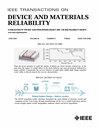Design of Highly Reliable 14T and 16T SRAM Cells Combined With Layout Harden Technique
IF 2.5
3区 工程技术
Q2 ENGINEERING, ELECTRICAL & ELECTRONIC
IEEE Transactions on Device and Materials Reliability
Pub Date : 2024-06-24
DOI:10.1109/TDMR.2024.3417961
引用次数: 0
Abstract
The node upset may occur in the memory cell if the charged particle from cosmos rays or packaging materials strikes the integrated circuit. Radiation-hardened-by-design (RHBD) techniques introduce redundant transistors in the SRAM cell to improve its ability of recovering from the undesired node upset. However, the extra redundant transistors may increase the number of sensitive nodes in the SRAM cell, which decreases its capability of node-upset tolerance in turn. This work proposes an RHBD 14T SRAM cell and an RHBD 16T SRAM cell. Both the proposed SRAM cells only have two sensitive nodes. The proposed SRAM cells are able to recover from all the SNU cases. The layout harden technique is used to protect the proposed cells from SEMNU, and the blank of the hardened layout is reused so the proposed 14T and 16T SRAM cells consume the same area. Although the proposed cells have more transistors, the hardened layout areas of NS-10T/ PS-10T/ RHD-12T/ RHBD-10T/ RHBD-10T[VLSI]/ QUCCE-12T are respectively结合布局硬化技术设计高可靠性 14T 和 16T SRAM 单元
如果来自宇宙射线或封装材料的带电粒子撞击到集成电路上,存储单元就会发生节点紊乱。辐射加固设计(RHBD)技术在 SRAM 单元中引入冗余晶体管,以提高其从意外节点干扰中恢复的能力。然而,额外的冗余晶体管可能会增加 SRAM 单元中敏感节点的数量,进而降低其节点上移耐受能力。本研究提出了一种 RHBD 14T SRAM 单元和一种 RHBD 16T SRAM 单元。这两种拟议的 SRAM 单元都只有两个敏感节点。所提出的 SRAM 单元能够从所有 SNU 情况中恢复。布局加固技术用于保护拟议的单元免受 SEMNU 的影响,加固布局的空白被重复使用,因此拟议的 14T 和 16T SRAM 单元占用的面积相同。虽然建议的单元拥有更多的晶体管,但NS-10T/ PS-10T/ RHD-12T/ RHBD-10T/ RHBD-10T[VLSI]/ QUCCE-12T的硬化布局面积分别比建议的单元大1.78/1.78/1.83/1.78/1.78/1.83/1.83/1.83/1.83/1.83/1.83/1.83/1.83/1.78/1.78/1.78/1.99美元。原因是布局加固技术更容易应用于提议的单元,因为它们只有两个敏感节点。
本文章由计算机程序翻译,如有差异,请以英文原文为准。
求助全文
约1分钟内获得全文
求助全文
来源期刊

IEEE Transactions on Device and Materials Reliability
工程技术-工程:电子与电气
CiteScore
4.80
自引率
5.00%
发文量
71
审稿时长
6-12 weeks
期刊介绍:
The scope of the publication includes, but is not limited to Reliability of: Devices, Materials, Processes, Interfaces, Integrated Microsystems (including MEMS & Sensors), Transistors, Technology (CMOS, BiCMOS, etc.), Integrated Circuits (IC, SSI, MSI, LSI, ULSI, ELSI, etc.), Thin Film Transistor Applications. The measurement and understanding of the reliability of such entities at each phase, from the concept stage through research and development and into manufacturing scale-up, provides the overall database on the reliability of the devices, materials, processes, package and other necessities for the successful introduction of a product to market. This reliability database is the foundation for a quality product, which meets customer expectation. A product so developed has high reliability. High quality will be achieved because product weaknesses will have been found (root cause analysis) and designed out of the final product. This process of ever increasing reliability and quality will result in a superior product. In the end, reliability and quality are not one thing; but in a sense everything, which can be or has to be done to guarantee that the product successfully performs in the field under customer conditions. Our goal is to capture these advances. An additional objective is to focus cross fertilized communication in the state of the art of reliability of electronic materials and devices and provide fundamental understanding of basic phenomena that affect reliability. In addition, the publication is a forum for interdisciplinary studies on reliability. An overall goal is to provide leading edge/state of the art information, which is critically relevant to the creation of reliable products.
 求助内容:
求助内容: 应助结果提醒方式:
应助结果提醒方式:


